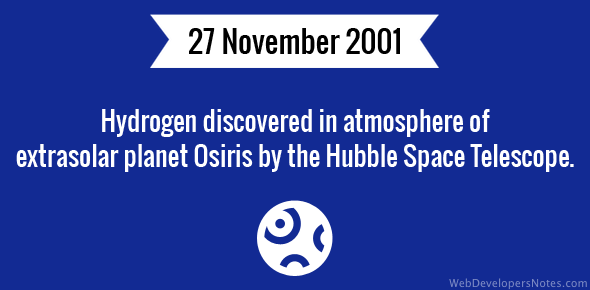The Hubble Space Telescope made a groundbreaking discovery on November 27, 2001, when it detected hydrogen in the atmosphere of the extrasolar planet Osiris (officially known as HD 209458b). This was the first atmospheric detection for any extrasolar planet. This finding was pivotal in the study of exoplanets, contributing to our understanding of their composition and structure, and marking a significant milestone in astronomical research.
The discovery of hydrogen in the atmosphere of Osiris was a remarkable achievement for the Hubble Space Telescope and the scientific community. It provided crucial evidence for the presence of a gaseous atmosphere surrounding an extrasolar planet, confirming the theoretical predictions of planetary atmospheres beyond our solar system.
The Hubble Space Telescope, launched into orbit by the Space Shuttle Discovery in 1990, has been instrumental in advancing our knowledge of the universe. Its ability to observe celestial objects with exceptional clarity and precision has revolutionized the field of astronomy. Over the years, Hubble has made numerous groundbreaking discoveries, but the detection of hydrogen in the atmosphere of Osiris stands out as a remarkable achievement.
The detection of hydrogen in the atmosphere of Osiris was made possible through a technique known as spectroscopy. Spectroscopy involves the analysis of light emitted or absorbed by a celestial object to determine its composition and properties. By observing the light from Osiris as it passed through its atmosphere, scientists were able to identify the presence of hydrogen molecules.
Osiris, located approximately 150 light-years away in the constellation Pegasus, is a gas giant similar in size to Jupiter. Its proximity to its parent star, HD 209458, and its short orbital period of just 3.5 days, make it an ideal candidate for atmospheric studies. The close proximity to its star causes the planet’s atmosphere to heat up, leading to the escape of some of its gases into space, including hydrogen.
The detection of hydrogen in the atmosphere of Osiris provided valuable insights into the composition and structure of exoplanets. It confirmed the presence of a gaseous envelope surrounding these distant worlds and opened up new avenues for studying their atmospheres. Scientists could now investigate the chemical makeup of exoplanet atmospheres, searching for other elements and molecules that could potentially support life.
Since the discovery of hydrogen in the atmosphere of Osiris, astronomers have continued to study exoplanets using various techniques and instruments. The Hubble Space Telescope itself has made further contributions to the field, detecting the presence of water vapor, carbon dioxide, and other elements in the atmospheres of different exoplanets. These findings have expanded our understanding of the diversity and complexity of planetary systems beyond our own.
The discovery of hydrogen in the atmosphere of Osiris has also paved the way for future space missions and telescopes dedicated to the study of exoplanets. The James Webb Space Telescope, set to launch in 2021, is expected to provide even more detailed observations of exoplanet atmospheres, potentially revealing the presence of biomarkers and signs of habitability.
In conclusion, the detection of hydrogen in the atmosphere of the extrasolar planet Osiris by the Hubble Space Telescope in 2001 was a groundbreaking discovery. It marked the first atmospheric detection for any extrasolar planet and significantly contributed to our understanding of exoplanets. This milestone achievement has paved the way for further research and exploration of distant worlds, bringing us closer to answering the age-old question of whether we are alone in the universe.
SEO Excerpt:
The Hubble Space Telescope made a groundbreaking discovery on November 27, 2001, when it detected hydrogen in the atmosphere of the extrasolar planet Osiris. This finding was pivotal in the study of exoplanets, contributing to our understanding of their composition and structure, and marking a significant milestone in astronomical research. Learn more about this remarkable achievement and its implications for the search for life beyond our solar system.

